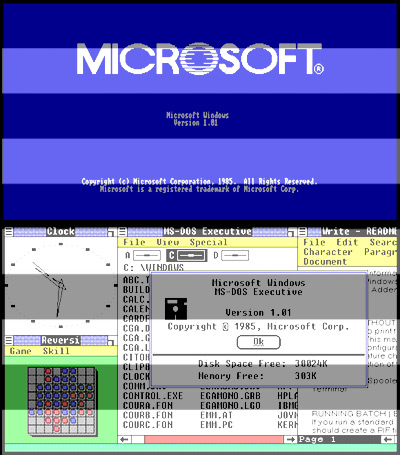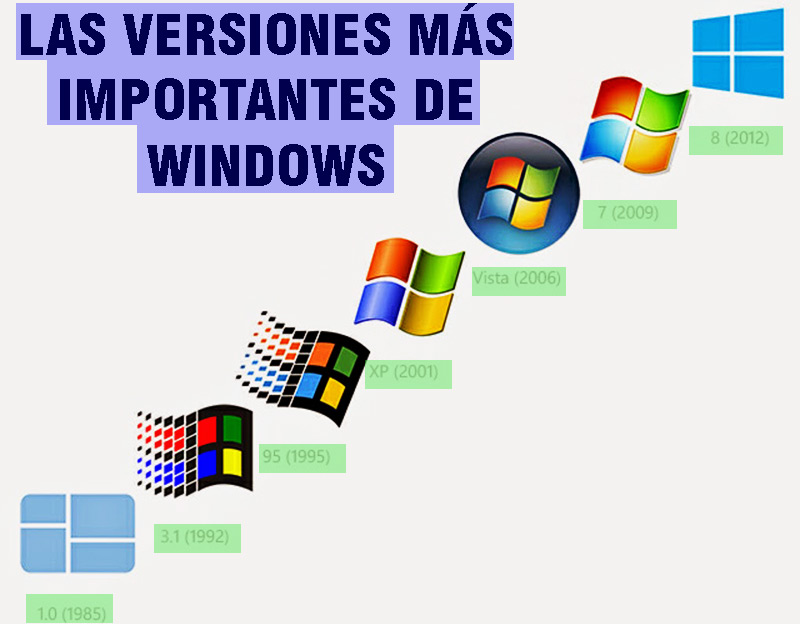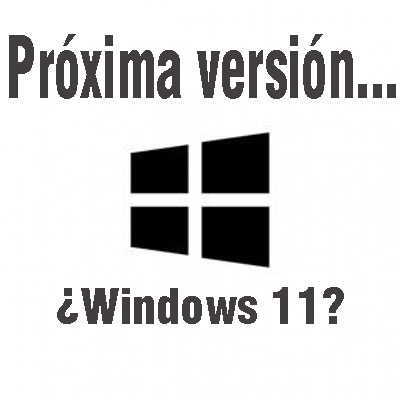
Index:
UPDATED ✅ Do you want to know what all the versions of the Windows operating system have been? ⭐ ENTER HERE ⭐ and discover each one ✅ EASY and FAST ✅
Over time, Microsoft Windows has been cataloged as one of the most complete operating systems. Therefore, it dominates this market with great comfort and thanks to this, it is installed on more than 90% of computers with Internet access.
In this sense, such an operating system can be defined as a set of programs that simplify the administration of the resources of a PC. In particular, due to the extensive development that has shown during its 36 years of existence. In this way, it is considered of great relevance to know what the versions of Windows are to date.
That is why, in this post, we will focus on detailing the most important aspects around to the origin and evolution of Microsoft Windows. Apart from that, chronologically, we will indicate the known versions of this OS, naming its most interesting features.
What unique features did the first version of Windows that came out have?

To begin to know more about what Microsoft Windows was like in its beginnings, it is necessary to narrow down the main characteristics that its first version exhibited. Which, we can exemplify by explaining a little about the origin and history of this renowned operating system.
Source
First of all, it should be noted that the OS in question owes its name to an English word that, in Spanish, means “Window” and of course, it is associated with the way in which the system presents the user with the resources of his computer. Thus simplifying the execution of the most common tasks to be carried out on the PC.
Now this computer system was developed and marketed from the year 1985 by the Microsoft company, which was founded by Bill Gates 10 years ago. That is, in 1975 and initially, began to distribute the old MS-DOS operating system.
In this sense, at first, Windows was only created as an MS-DOS add-in. However, in view of the new Graphical User Interface (GUI) that it showed to the public, it was considered one of the best computer proposals.
Although, certainly, it had some limitations and among them, the inability to include a recycle bin or ensure window overlap. Put, this was prevented by Apple to protect its operating system and thus prevent Microsoft from plagiarizing its product.
History
In reference to its history, Microsoft Windows did not have as easy beginnings as the public believes. Since, this SO was highly criticized and accused by engage in unfair competition against Apple and with it, he was involved in a great controversy.
However, after this and thanks to its popularity for being free software in constant growth and development, it took on a remarkable boom and attracted many manufacturers and buyers. This, from its version 1.0 in which around 55 programmers were employed and was released on November 20, 1985, specifically.
This version was originally called “InterfaceManager”but one of the marketing managers of the Microsoft company, limited that it would be better to name it “windows” to attract more to the whole market. Basically, it supported the use of device-independent mouse, screen and printer graphics, as well as drop-down menus.
Timeline of all versions of the Windows operating system that exist

Now, we have reached the section of the post where we will detail each and every one of the versions that have existed of Microsoft Windows. Which of course we will chronologically and emphasizing the features of greatest interestnext:
Windows 1.0
Release Date: November 20, 1985
As we indicated earlier, the first version of Windows was known as 1.0, which could be called “InterfaceManager”but when analyzing certain aspects of marketing, they decided to simply call “windows”.
Among all, this version was distinguished by the criticism it received be a kind of “copy” of the Apple interface. Indeed, it failed to include certain native Apple ideas, such as the recycle bin. Which, he added later when reaching an agreement with the apple company.
Taking into account some other details, we specify that Windows 1.0 emerged as a graphical complement to the DOS operating system. Also, its best novelty it was simply the incorporation of the Control Panel.
Windows 2.0
Release Date: December 09, 1987
Two years later, the second official version of the operating system in question is launched on the market. Which, although it was also designed to operate as an MS-DOS plugin, gained slightly more popularity than its predecessor.
In this sense, its success was thanks to the incorporation of new applications to facilitate certain tasks for its users, among which are: Excel and Word. In addition to that, it also added overlapping windows, icons, and PIF files for Microsoft’s DOS operating system.
It should be noted that this version received updates for 14 yearsso it only had technical support from the company until 2001.
Windows NT
Release Date: November 1988
Before the publication of Windows NT, apart from version 2.0, others were also known such as: Windows/286 2.10 and Windows/386 2.10. Which were launched around May 27, 1988 and were characterized by using memory in real mode and supporting, for the first time, HMA or High Memory Area (high memory area, in Spanish).
However, in that same year, Windows NT emerged once the company contracted “Digital Equipment Corporation”, a group of developers who were led by Dave Cutler. Thus, it was considered one of the most important of that time due to the fact that it worked on multiple sets of computer architecture instructions and on multiple hardware platforms. Also, he was the first to introduce the Win32 API.
But, only until the year 2001, this version of Windows is publicly demonstrated. which, at the time, was called “Windows Advanced Server for LAN Manager” at a developer conference.
Windows 3.0
Release Date: May 22, 1990
In 1990, the Microsoft Windows 3.0 operating system is released and launched, which had more noticeable changes compared to the previously released versions. Although, at this point, they still belonged to the graphical user interface of the MS-DOS operating system.
Through this version of the OS, it was already possible to make use of the File Manager and Program Manager, for the first time. Taking into account that, from this, one of the most important versions was designed (specifically, 3.1 that we detail below).
Windows 3.1
Release date: April 06, 1992
With the emergence of version 3.0, the design and development of Microsoft Windows 3.1 began, which, in original code, was known as “Janus”. In this, thanks to the system of TrueType fonts that is cataloged as a set of highly readable fonts, Windows was considered a viable platformfor the first time and also worthy of being an operating system independent of Microsoft DOS.
In this sense, Windows 3.1 showed great success for its use of TrueType fonts and in addition to that, for other highly relevant graphic additions. Because of this, Windows managed to outperform IBM’s operating system in terms of sales and the design of a new update called “Windows 3.11” was started, which had even more sales.
Windows 95
Release Date: August 24, 1995
Initially, this version of Windows was known under the code name Chicago and was completely consumer oriented. Since it was an operating system designed to have support for preventive multitasking and one of its biggest changes was evident in the 32-bit code.
However, Chicago left some parts of the code at 16 bits, but without directly using real mode for performance, compatibility and development time issues. Now, shortly before its release, they decided to call the version as “Windows 95” and it exhibited three advantages of great interest:
- It was not possible to run this OS on non-Microsoft versions of DOS. That is, it was only accepted in MS-DOS.
- It only ran on 386 enhanced mode, with virtual memory and a 32-bit address space. Therefore, he could even have 2 GB of virtual RAM.
- Added the Start menu and taskbar, as well as included internet support.
Windows 98
Release date: June 25, 1998
Starting with this version of the operating system, excellent graphical improvements were made, which were much more noticeable than in older versions. Also standing out for include the input of DVDs and the incorporation of the USB port. Taking into account that, at this point, the software and hardware requirements were increasingly demanding.
However, due to some errors caused by the Internet Explorer browser, the company decided to release a second version of Windows 98, but in 1999. Which, operated under the name “Windows 98 Second Edition” and in addition to eliminating these errors, it had the ability to allow multiple computers to connect to the same Internet connection, simultaneously.
It should be noted that the Windows 98 version was only supported by Microsoft until July 2006that is, for eight years in total.
Windows 2000
Release Date: February 17, 2000
During this year, users began to buy the full version of Windows 2000. Which, was based on NT technology from one of the versions years ago and considered a more sophisticated operating system.
After that, specifically on September 14 of the same year, a new version called “Windows Millennium Edition” and just a few days later, on September 29, it was published “Windows 2000 Data Center Server” that it was a version with support for 32 processors and thus, it was aimed at large computing systems.
Windows Xp
Release date: October 25, 2001
Just one year later, the Windows XP version was released, which remains one of the most recognized to date. Since, it starred in a great change that Microsoft had with Windows due to the extraordinary graphical improvements, greater agility and a great increase in speed.
In addition to this, Windows XP is characterized by being Microsoft’s first operating system to add a 64-bit version. It also incorporated excellent functions such as system file encryption, remote assistance, Wi-Fi network support and in view of this and many other features, it was able to make a great explosion in the operating system market worldwide.
Windows Vista
Release date: January 30, 2007
It took six years for a new official version of Microsoft Windows to be released. Which concluded its development process on November 8, 2006 and was made available for sale in volume licenses for large companies on November 30, 2006. However, it was released until 2007 for general users.
Among its most interesting features, we highlight that this version could be obtained directly from the Microsoft website, where they facilitated its purchase and download. In which, added graphic improvements and the upgrade system to higher versions with Windows Anytime Upgrade. But, it was not the most successful OS, since it is even considered one of the worst failures of the technology company.
Said failure resulted from the large number of errors that it showed in the interface, despite the fact that the company had high expectations with it. In such a way that it only ended up being the operating system slowest and most overloaded.
Windows 7
Release date: October 22, 2009
Although its development was completed on July 22, 2009, it was published until October of that same year. Said development took two years after the Vista version and through it, Microsoft wanted to correct everything bad that its predecessor had shown.
For this reason, with Windows 7 it was possible to obtain an operating system with much more efficiency and excellent improvements in terms of security, performance and the most important system requirements. In addition to this, it is a Windows proposal that is completely adaptable to its use in systems with touch screens.
Among other details of interest, through this version, an improvement in consumer assistance was also promoted. To do this, to be able to solve the most common problems of the operating system and It also showed a new taskbar design along with a more elegant icon system. and, ultimately, a better interface.
Windows 8
Release date: October 26, 2012
After three years, the company published its version of Windows 8, which was released together with the latest edition of the Windows Server operating system. Among its main peculiarities and of greatest interest, we find that Windows added support for ARM microprocessors, for the first time. In addition to the traditional x86 microprocessors from AMD and Intel.
Regarding its user interface, it was modified with the purpose of make it more suitable for use on touch screens and of course, for traditional keyboard and mouse systems. Because, it is intended to be a universal operating system independent of the platform on which it is installed.
Now, it had some changes with respect to its predecessor Windows 7. Since, the Aero Glass effect was no longer present in the operating system, since was replaced by new flat effects with a simple color for windows and buttons.
Windows 10
Release date: July 29, 2015
So far, this is the latest version released by Microsoft Windows. Being an operating system that is characterized by introduce support for PCs, laptops and mobile devicesso it has several versions within itself and they are:
- Windows 10 Home
- Windows 10 Pro
- Windows 10 Enterprise
- Windows 10 Education
- Windows 10 Mobile (for mobile phones)
- Windows 10 S (for lower potential touch devices, such as tablets)
- Windows 10 IoT Core
- Windows 10 Pro for Workstations (for higher potential computers or workstations).
In this way, it is the newest version of Windows that has a Start menu with the Modern UI interface combined with that of Windows 7. In addition to that, it contains notification center, multiple desktops, shows changes in some system icons and to a reporting application mistakes. Additionally, it supports a touch mode and has optimized multitasking.
What will be the next version of Windows and what can we expect from it?

According to some unofficial data, it is estimated that Windows 10 could expire on October 14, 2025. Since, until that date is that it has extended support while its standard support will end on October 13, 2020. So, around 2018, it was known that there will be a Windows 11 soon.
Of course, the vast majority of users expect Microsoft to make profound changes in said version. Whether it’s optimizing the entire process that currently handles the operating system or even modifying the strategy of when they talk about “a latest version of Windows”.
So, beyond the development model that the company manages, it is considered that Windows 11 will have to solve certain issues. around the user interfaceby including some curved designs and a start menu that could have optional tiles and smart animations.
That is to say, exhibit a truly consistent and additional design, some experts have limited that it would be decisive that it will have a redesigned search, adaptive cursors and a dark mode (as many platforms already do).
Operating systems